Economic Principles and Decision Making Assignment - University Name
VerifiedAdded on 2021/04/21
|7
|835
|44
Homework Assignment
AI Summary
This economics assignment explores core economic principles and decision-making processes. It begins with an analysis of the Production Possibility Frontier (PPF), illustrating concepts like efficient production, inefficient production, and infeasible output combinations. The assignment then delves into supply and demand analysis, calculating equilibrium price and quantity, and examining how changes in price affect both demand and supply, adhering to the laws of demand and supply. The student demonstrates an understanding of these principles by solving problems related to PPF shifts and market equilibrium adjustments, providing clear explanations and calculations. The assignment showcases the application of fundamental economic concepts to real-world scenarios, with proper citations from economic textbooks.
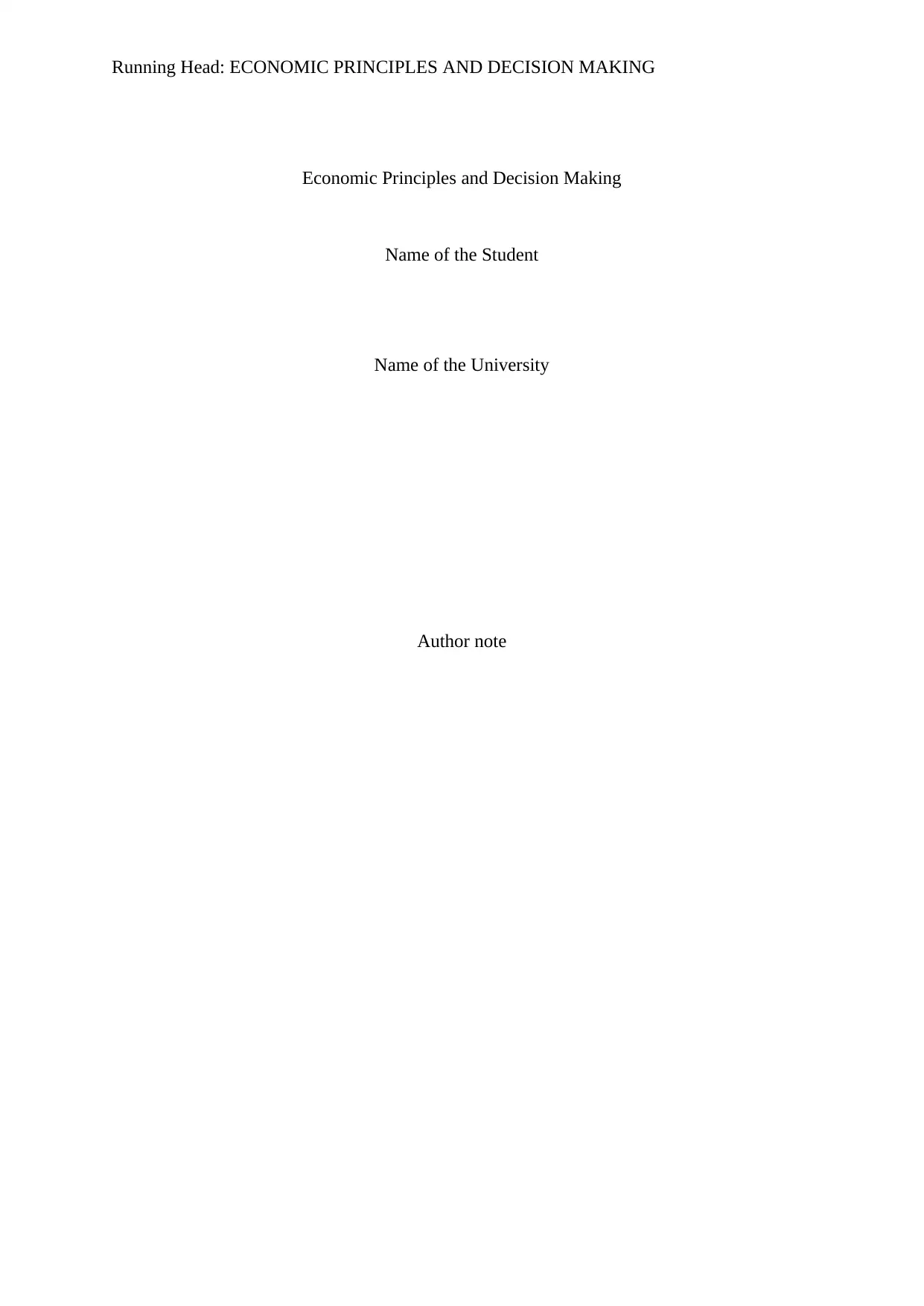
Running Head: ECONOMIC PRINCIPLES AND DECISION MAKING
Economic Principles and Decision Making
Name of the Student
Name of the University
Author note
Economic Principles and Decision Making
Name of the Student
Name of the University
Author note
Paraphrase This Document
Need a fresh take? Get an instant paraphrase of this document with our AI Paraphraser
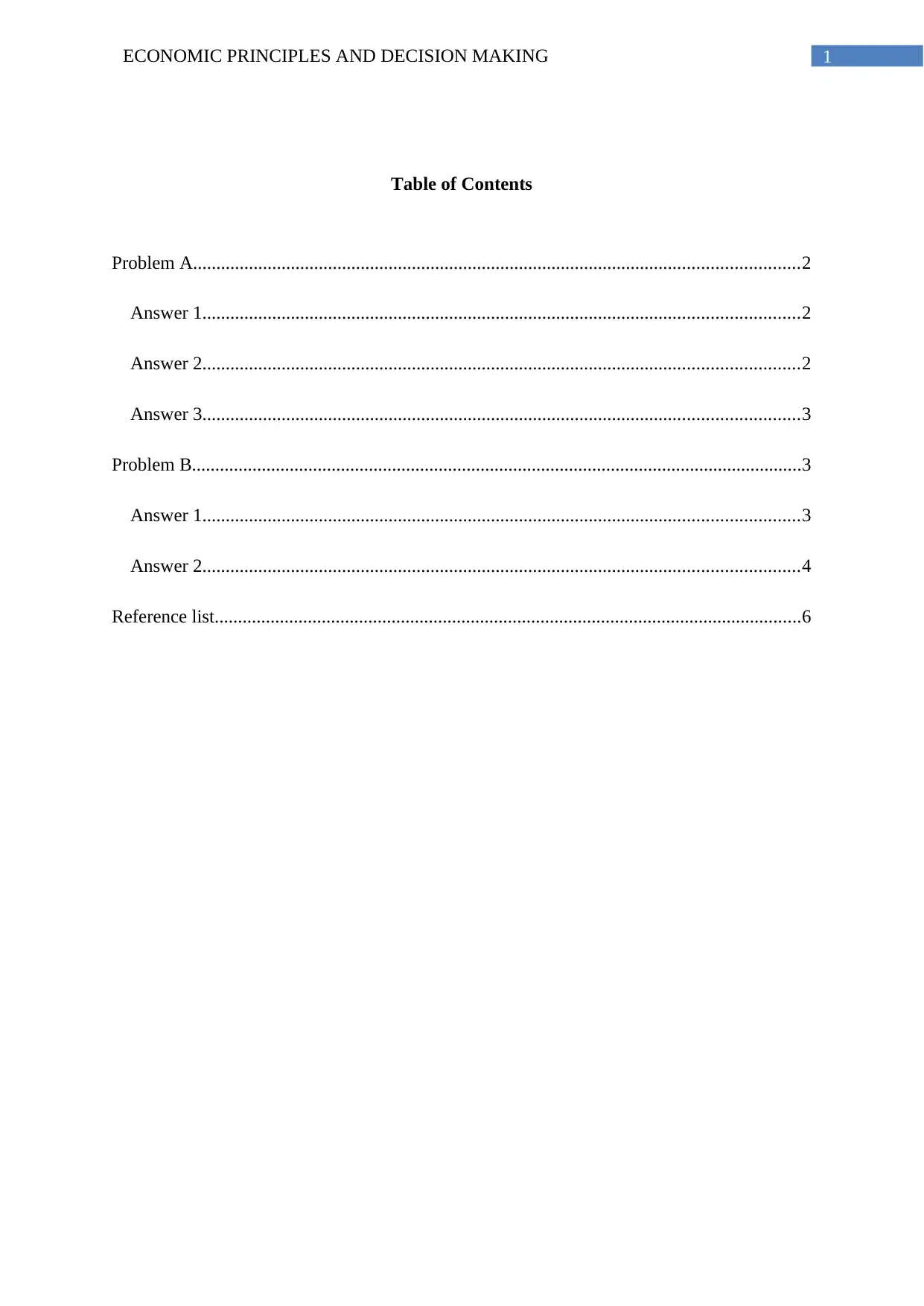
1ECONOMIC PRINCIPLES AND DECISION MAKING
Table of Contents
Problem A..................................................................................................................................2
Answer 1................................................................................................................................2
Answer 2................................................................................................................................2
Answer 3................................................................................................................................3
Problem B...................................................................................................................................3
Answer 1................................................................................................................................3
Answer 2................................................................................................................................4
Reference list..............................................................................................................................6
Table of Contents
Problem A..................................................................................................................................2
Answer 1................................................................................................................................2
Answer 2................................................................................................................................2
Answer 3................................................................................................................................3
Problem B...................................................................................................................................3
Answer 1................................................................................................................................3
Answer 2................................................................................................................................4
Reference list..............................................................................................................................6
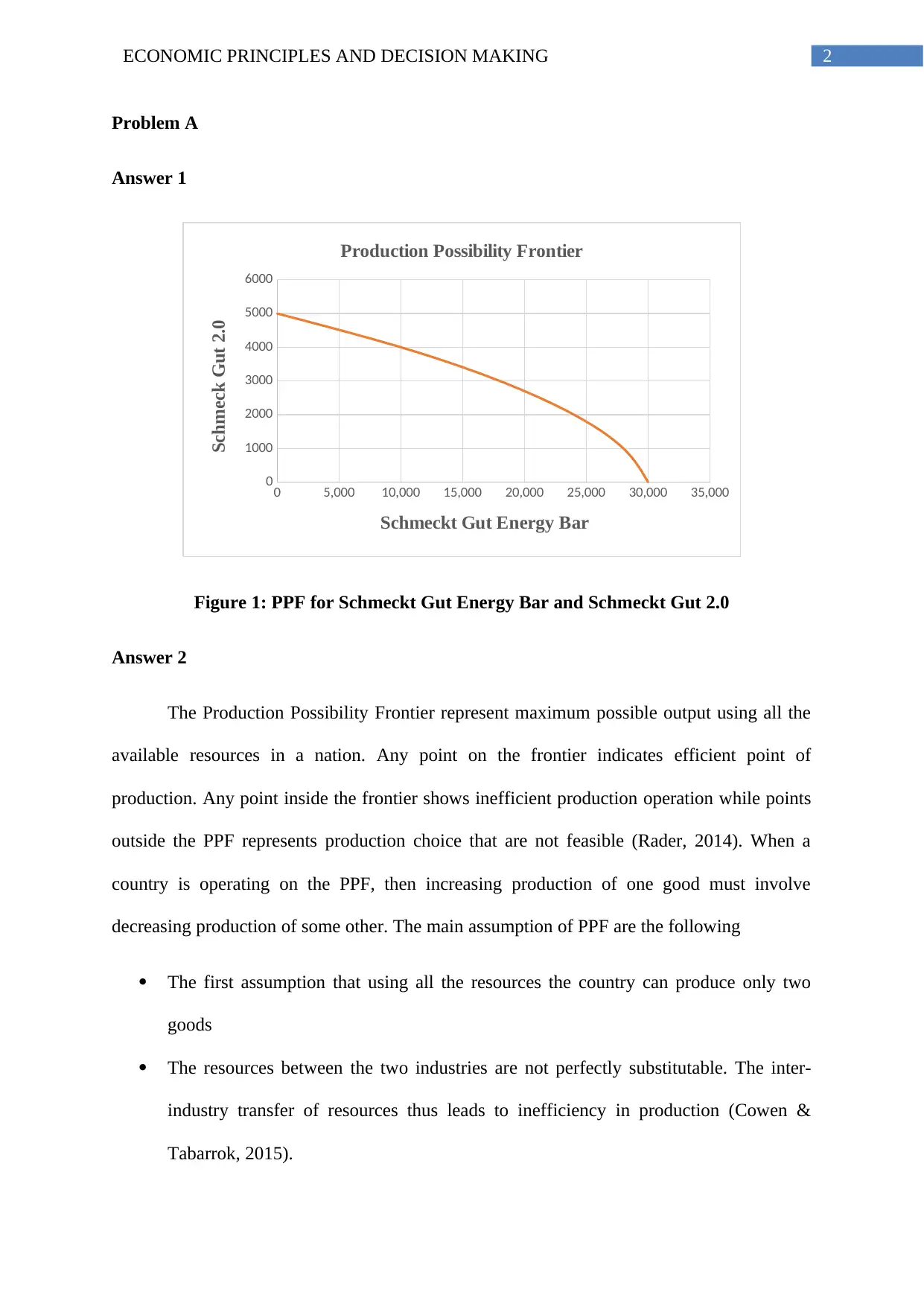
2ECONOMIC PRINCIPLES AND DECISION MAKING
Problem A
Answer 1
0 5,000 10,000 15,000 20,000 25,000 30,000 35,000
0
1000
2000
3000
4000
5000
6000
Production Possibility Frontier
Schmeckt Gut Energy Bar
Schmeck Gut 2.0
Figure 1: PPF for Schmeckt Gut Energy Bar and Schmeckt Gut 2.0
Answer 2
The Production Possibility Frontier represent maximum possible output using all the
available resources in a nation. Any point on the frontier indicates efficient point of
production. Any point inside the frontier shows inefficient production operation while points
outside the PPF represents production choice that are not feasible (Rader, 2014). When a
country is operating on the PPF, then increasing production of one good must involve
decreasing production of some other. The main assumption of PPF are the following
The first assumption that using all the resources the country can produce only two
goods
The resources between the two industries are not perfectly substitutable. The inter-
industry transfer of resources thus leads to inefficiency in production (Cowen &
Tabarrok, 2015).
Problem A
Answer 1
0 5,000 10,000 15,000 20,000 25,000 30,000 35,000
0
1000
2000
3000
4000
5000
6000
Production Possibility Frontier
Schmeckt Gut Energy Bar
Schmeck Gut 2.0
Figure 1: PPF for Schmeckt Gut Energy Bar and Schmeckt Gut 2.0
Answer 2
The Production Possibility Frontier represent maximum possible output using all the
available resources in a nation. Any point on the frontier indicates efficient point of
production. Any point inside the frontier shows inefficient production operation while points
outside the PPF represents production choice that are not feasible (Rader, 2014). When a
country is operating on the PPF, then increasing production of one good must involve
decreasing production of some other. The main assumption of PPF are the following
The first assumption that using all the resources the country can produce only two
goods
The resources between the two industries are not perfectly substitutable. The inter-
industry transfer of resources thus leads to inefficiency in production (Cowen &
Tabarrok, 2015).
⊘ This is a preview!⊘
Do you want full access?
Subscribe today to unlock all pages.

Trusted by 1+ million students worldwide
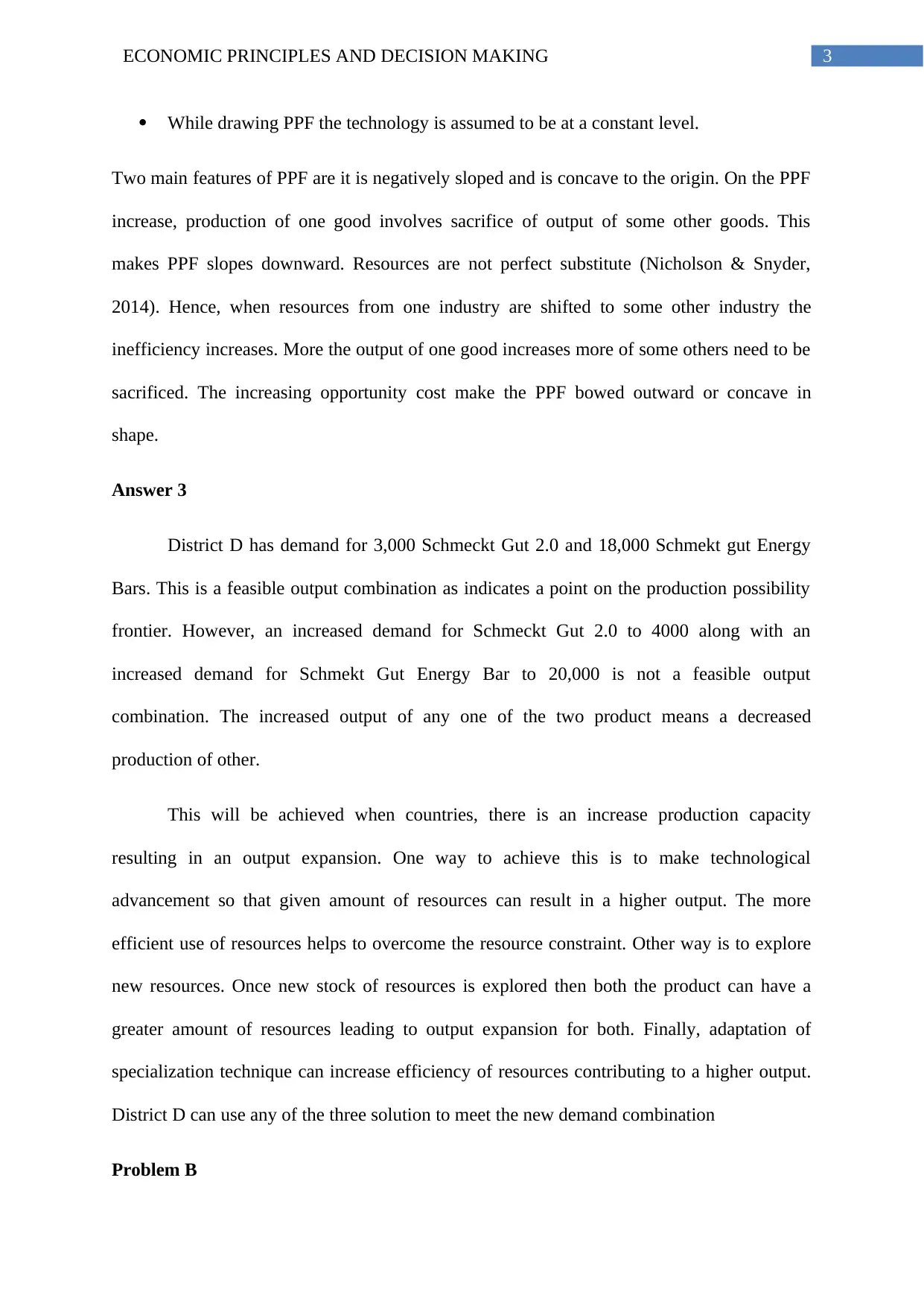
3ECONOMIC PRINCIPLES AND DECISION MAKING
While drawing PPF the technology is assumed to be at a constant level.
Two main features of PPF are it is negatively sloped and is concave to the origin. On the PPF
increase, production of one good involves sacrifice of output of some other goods. This
makes PPF slopes downward. Resources are not perfect substitute (Nicholson & Snyder,
2014). Hence, when resources from one industry are shifted to some other industry the
inefficiency increases. More the output of one good increases more of some others need to be
sacrificed. The increasing opportunity cost make the PPF bowed outward or concave in
shape.
Answer 3
District D has demand for 3,000 Schmeckt Gut 2.0 and 18,000 Schmekt gut Energy
Bars. This is a feasible output combination as indicates a point on the production possibility
frontier. However, an increased demand for Schmeckt Gut 2.0 to 4000 along with an
increased demand for Schmekt Gut Energy Bar to 20,000 is not a feasible output
combination. The increased output of any one of the two product means a decreased
production of other.
This will be achieved when countries, there is an increase production capacity
resulting in an output expansion. One way to achieve this is to make technological
advancement so that given amount of resources can result in a higher output. The more
efficient use of resources helps to overcome the resource constraint. Other way is to explore
new resources. Once new stock of resources is explored then both the product can have a
greater amount of resources leading to output expansion for both. Finally, adaptation of
specialization technique can increase efficiency of resources contributing to a higher output.
District D can use any of the three solution to meet the new demand combination
Problem B
While drawing PPF the technology is assumed to be at a constant level.
Two main features of PPF are it is negatively sloped and is concave to the origin. On the PPF
increase, production of one good involves sacrifice of output of some other goods. This
makes PPF slopes downward. Resources are not perfect substitute (Nicholson & Snyder,
2014). Hence, when resources from one industry are shifted to some other industry the
inefficiency increases. More the output of one good increases more of some others need to be
sacrificed. The increasing opportunity cost make the PPF bowed outward or concave in
shape.
Answer 3
District D has demand for 3,000 Schmeckt Gut 2.0 and 18,000 Schmekt gut Energy
Bars. This is a feasible output combination as indicates a point on the production possibility
frontier. However, an increased demand for Schmeckt Gut 2.0 to 4000 along with an
increased demand for Schmekt Gut Energy Bar to 20,000 is not a feasible output
combination. The increased output of any one of the two product means a decreased
production of other.
This will be achieved when countries, there is an increase production capacity
resulting in an output expansion. One way to achieve this is to make technological
advancement so that given amount of resources can result in a higher output. The more
efficient use of resources helps to overcome the resource constraint. Other way is to explore
new resources. Once new stock of resources is explored then both the product can have a
greater amount of resources leading to output expansion for both. Finally, adaptation of
specialization technique can increase efficiency of resources contributing to a higher output.
District D can use any of the three solution to meet the new demand combination
Problem B
Paraphrase This Document
Need a fresh take? Get an instant paraphrase of this document with our AI Paraphraser
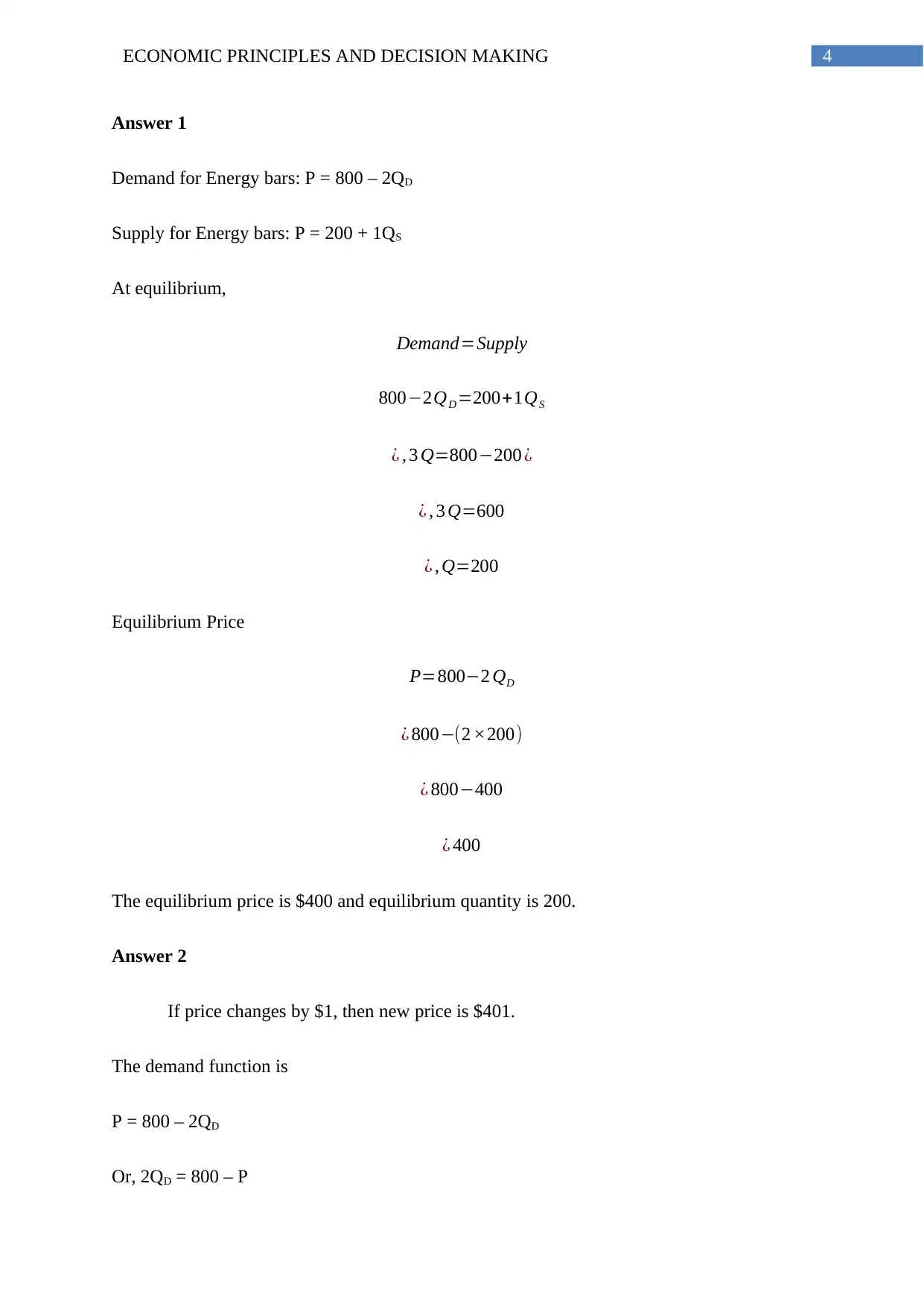
4ECONOMIC PRINCIPLES AND DECISION MAKING
Answer 1
Demand for Energy bars: P = 800 – 2QD
Supply for Energy bars: P = 200 + 1QS
At equilibrium,
Demand=Supply
800−2QD =200+1QS
¿ , 3 Q=800−200 ¿
¿ , 3 Q=600
¿ , Q=200
Equilibrium Price
P=800−2 QD
¿ 800−(2 ×200)
¿ 800−400
¿ 400
The equilibrium price is $400 and equilibrium quantity is 200.
Answer 2
If price changes by $1, then new price is $401.
The demand function is
P = 800 – 2QD
Or, 2QD = 800 – P
Answer 1
Demand for Energy bars: P = 800 – 2QD
Supply for Energy bars: P = 200 + 1QS
At equilibrium,
Demand=Supply
800−2QD =200+1QS
¿ , 3 Q=800−200 ¿
¿ , 3 Q=600
¿ , Q=200
Equilibrium Price
P=800−2 QD
¿ 800−(2 ×200)
¿ 800−400
¿ 400
The equilibrium price is $400 and equilibrium quantity is 200.
Answer 2
If price changes by $1, then new price is $401.
The demand function is
P = 800 – 2QD
Or, 2QD = 800 – P
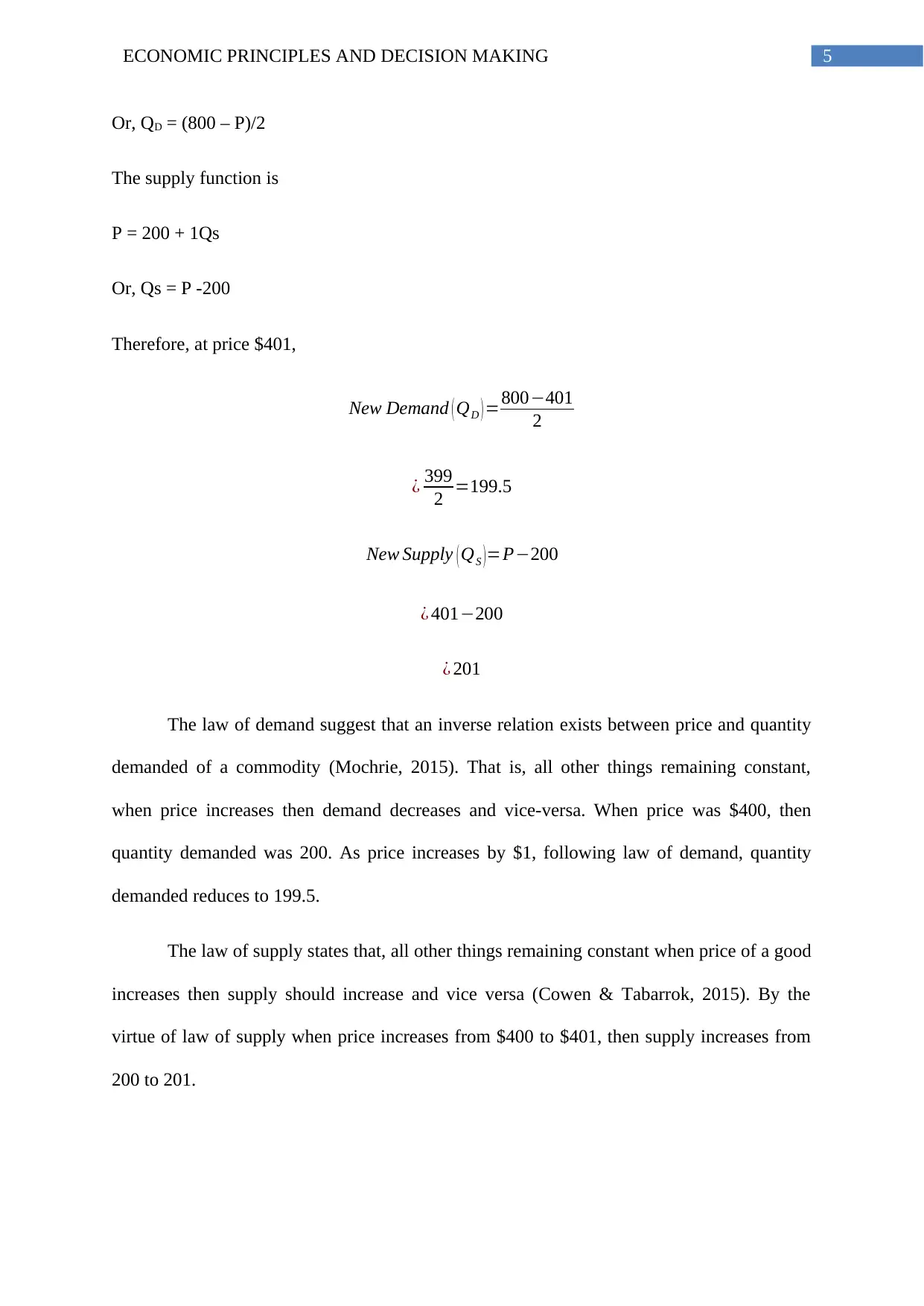
5ECONOMIC PRINCIPLES AND DECISION MAKING
Or, QD = (800 – P)/2
The supply function is
P = 200 + 1Qs
Or, Qs = P -200
Therefore, at price $401,
New Demand ( QD ) =800−401
2
¿ 399
2 =199.5
New Supply ( QS )=P−200
¿ 401−200
¿ 201
The law of demand suggest that an inverse relation exists between price and quantity
demanded of a commodity (Mochrie, 2015). That is, all other things remaining constant,
when price increases then demand decreases and vice-versa. When price was $400, then
quantity demanded was 200. As price increases by $1, following law of demand, quantity
demanded reduces to 199.5.
The law of supply states that, all other things remaining constant when price of a good
increases then supply should increase and vice versa (Cowen & Tabarrok, 2015). By the
virtue of law of supply when price increases from $400 to $401, then supply increases from
200 to 201.
Or, QD = (800 – P)/2
The supply function is
P = 200 + 1Qs
Or, Qs = P -200
Therefore, at price $401,
New Demand ( QD ) =800−401
2
¿ 399
2 =199.5
New Supply ( QS )=P−200
¿ 401−200
¿ 201
The law of demand suggest that an inverse relation exists between price and quantity
demanded of a commodity (Mochrie, 2015). That is, all other things remaining constant,
when price increases then demand decreases and vice-versa. When price was $400, then
quantity demanded was 200. As price increases by $1, following law of demand, quantity
demanded reduces to 199.5.
The law of supply states that, all other things remaining constant when price of a good
increases then supply should increase and vice versa (Cowen & Tabarrok, 2015). By the
virtue of law of supply when price increases from $400 to $401, then supply increases from
200 to 201.
⊘ This is a preview!⊘
Do you want full access?
Subscribe today to unlock all pages.

Trusted by 1+ million students worldwide
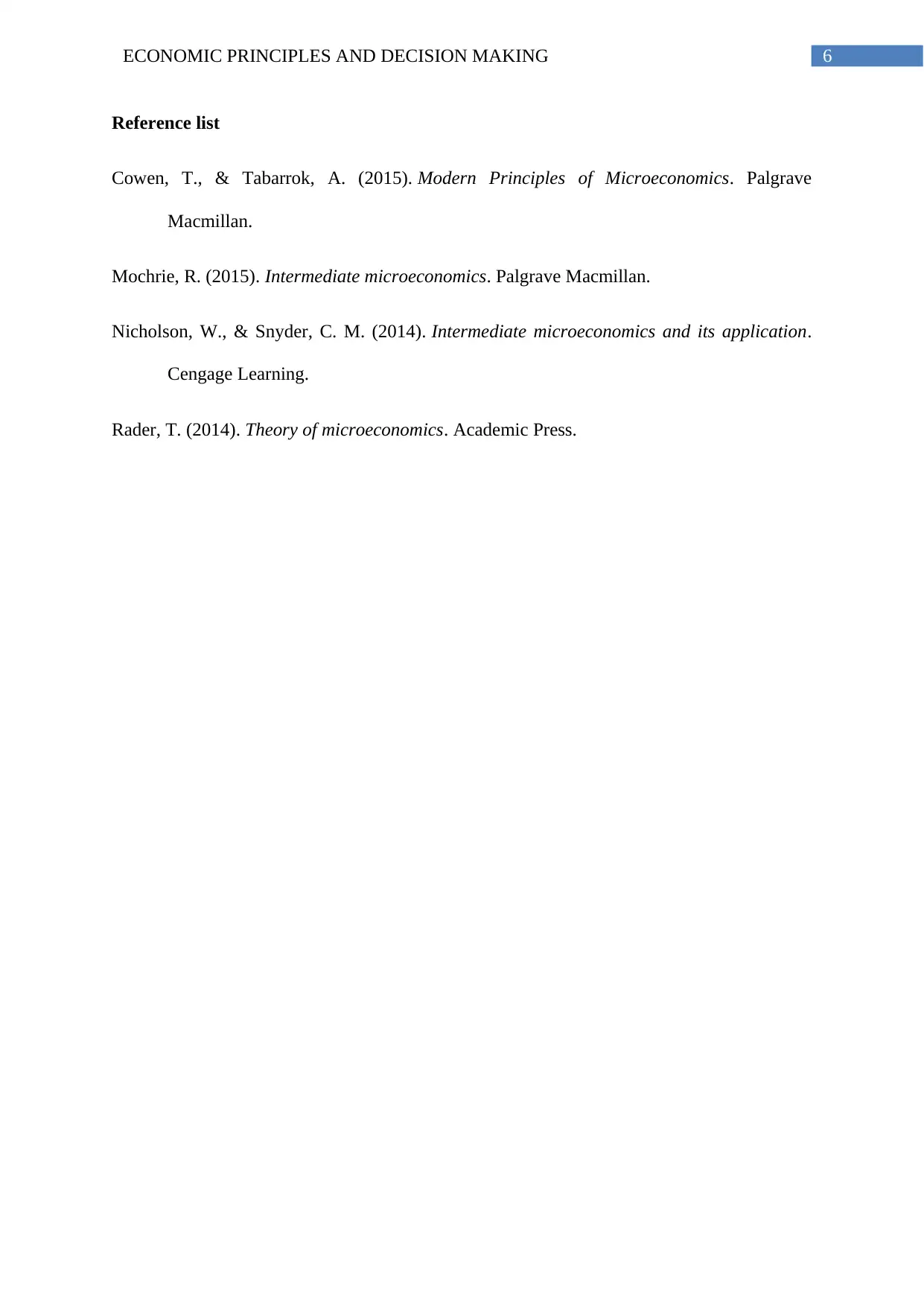
6ECONOMIC PRINCIPLES AND DECISION MAKING
Reference list
Cowen, T., & Tabarrok, A. (2015). Modern Principles of Microeconomics. Palgrave
Macmillan.
Mochrie, R. (2015). Intermediate microeconomics. Palgrave Macmillan.
Nicholson, W., & Snyder, C. M. (2014). Intermediate microeconomics and its application.
Cengage Learning.
Rader, T. (2014). Theory of microeconomics. Academic Press.
Reference list
Cowen, T., & Tabarrok, A. (2015). Modern Principles of Microeconomics. Palgrave
Macmillan.
Mochrie, R. (2015). Intermediate microeconomics. Palgrave Macmillan.
Nicholson, W., & Snyder, C. M. (2014). Intermediate microeconomics and its application.
Cengage Learning.
Rader, T. (2014). Theory of microeconomics. Academic Press.
1 out of 7
Related Documents
Your All-in-One AI-Powered Toolkit for Academic Success.
+13062052269
info@desklib.com
Available 24*7 on WhatsApp / Email
![[object Object]](/_next/static/media/star-bottom.7253800d.svg)
Unlock your academic potential
Copyright © 2020–2025 A2Z Services. All Rights Reserved. Developed and managed by ZUCOL.



